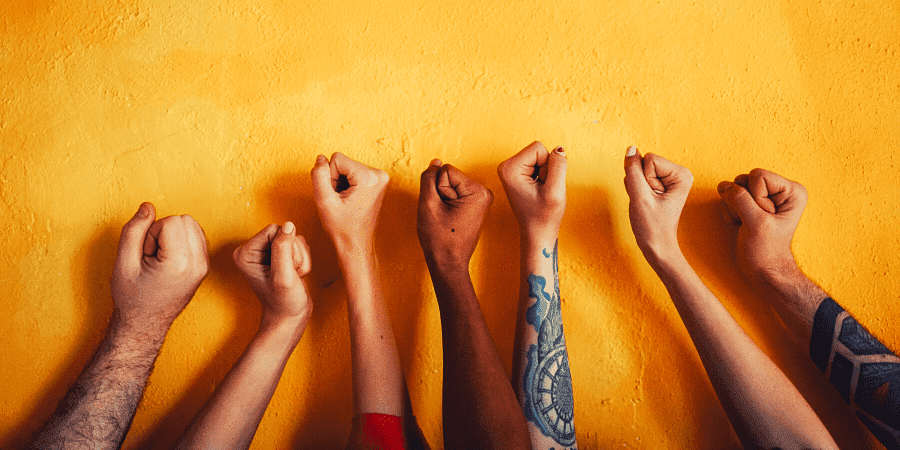This article gives a brief summary for quick revision during exams, and MCQs of NBSE Class 10 Social Science Chapter 11 "Working of Democracy".
Contents
Introduction to the chapter Working of Democracy: Most countries have social divisions, and their political expression is visible and desirable in a democracy. Democracy is strengthened as well as weakened by it. It all depends on the citizens of a country, as well as the political parties and leaders of those parties.
- A nation's unity, integrity, and prosperity are ensured if they prioritise the nation over social differences.
- Democracy and the very unity of a country are jeopardised if social divisions take precedence.
Gender and its influence on politics
The gender divide is a prominent social division in our country. It is widely assumed to be natural and unchangeable. For centuries, it has been based on social expectations and stereotypes of women. Boys and girls are raised differently.
- They are taught that the primary responsibility of women is housework and child-rearing. Men's primary responsibility is to provide bread and butter for their families.
- Women were confined to the four walls of their homes due to the gender division of labour. Even today, their influence in politics and public life is limited.
- Despite the fact that we have reserved seats for them in local self-governments and that many of them are MLAs and MPs, their overall representation in political life is minimal.
- Women did not have voting rights in most countries until the early decades of the twentieth century. They were unable to participate in the electoral process or run for public office.
- Women gradually organised and campaigned for voting rights. They also demanded several other rights, such as equal pay for equal work, increased educational and career opportunities, equality in personal and family life, maternity leave in the workplace, and so on. These movements are referred to collectively as Feminist Movements.
The condition of women in our society
Indian society is still dominated by patriarchy. Male dominance exists in the family, the workplace, and all aspects of life. The father, not the mother, is the family's head. Male members of a family make the majority of family decisions. There are still large joint families in rural areas.
- The Hindu Code Bill was passed during Jawaharlal Nehru's prime ministership. It raised the age of consent and marriage, upheld monogamy, gave women the right to divorce, maintenance, and inheritance, and treated dowry as Stridhan or women's property.
- Women have recently been granted the legal right to inherit their father's agricultural property. Dowry laws have become increasingly strict.
- Women have a literacy rate of 65.46 per cent, while men have a rate of 82.14 per cent. Girls drop out of school at a much higher rate than boys. This is due to poverty and a low income. Parents would rather spend their money on boys who will be future breadwinners for the family than on girls who will be married off and become part of another family. In higher and technical education, the proportion of female students is significantly lower than that of male students.
- The proportion of women in high-paying jobs and positions of power remains very low. On average, a woman works one hour longer per day than a man. However, women's work is not recognised because much of it is unpaid housework.
- Women are paid less than men for equal work in almost all fields. Despite the Equal Wages Act, which requires equal pay for equal work, this is not the case.
- Women have extremely high expectations. She is expected to be the ideal wife, mother of children, and daughter-in-law who brings a large dowry and looks after the elderly. A working woman must work in an office while also taking care of household responsibilities.
- Indians continue to prefer the birth of sons over daughters. Despite the fact that such abortions are illegal, a girl child is sometimes aborted before birth. As a result, the country's sex ratio has decreased.
- According to the 2011 Census, the sex ratio is 940 females for every 1000 males, up from 933 in 2001. In 1991, the figure was 927. In 1951, the figure had dropped from 972 females per 1000 males in 1901 to 946.
- The country's child sex ratio (number of girls per thousand boys) is only 914. (Census 201l).
- Domestic violence is still common.
- For dowry, women are beaten and harassed by their in-laws. Workplace exploitation and harassment of various kinds are frequently reported in the media.
Women's Representation in Politics
Despite significant improvements in women's conditions, there is still much work to be done. Many social and political thinkers, as well as leaders of women's movements, believe that only women's empowerment can solve their problems. More women should be elected to legislative bodies such as parliaments and state legislatures.
- The proportion of elected women in the Lok Sabha is around 10%. Their representation in state legislatures is less than 6%. Women have a low representation in the union and state councils of ministers.
- Despite the fact that we have had a woman Prime Minister for a long time (Indira Gandhi) and a woman President (Pratibha Patil), as well as some female Chief Ministers and governors, women's overall political representation is quite low in comparison to other countries/regions.
- Women now have one-third of the seats in panchayats and municipalities, thanks to the Panchayati Raj Amendment Act. In these bodies, we have over ten lakh elected women representatives.
- The Women's Reservation Bill, which calls for 33% reservation of seats in the Lok Sabha and State Assemblies for women, is currently being debated in Parliament. On various provisions of the Bill, there is no agreement among the various political parties. Some parties believe that if the Bill is passed in its current form, the majority of winning candidates will be from upper castes due to a lack of suitable candidates from lower castes, scheduled castes, and tribes.
Communalism and how it shapes politics
It is called communalism when religion is expressed in politics in exclusive and partisan terms when one religion and its followers are pitted against another, when the state promotes the dominance of one religion over all others, and when one religion's beliefs and practices are deemed superior to those of other religions.
- Majoritarianism refers to the political dominance of majority religious groups over minority religious groups. As in Sri Lanka, where Buddhists outnumber Tamil Hindus, Muslims, and Christians. Minority community members have a strong desire to form a separate nation or autonomous political unit.
- For political gain, political leaders use sacred symbols, local religious leaders, emotional appeal, and fear to polarise people of one religion. This is common during elections.
Caste’s influence on politics
The political expression of gender division has been largely positive, resulting in an improvement in the overall condition of women in our society and around the world. The majority of political expressions of religion have been negative, with far-reaching negative consequences for our country, society, and even the world.
- Political manifestations of casteism have resulted in both positive and negative outcomes. Casteism is a one-of-a-kind phenomenon in our society.
- Casteism is the belief that people belonging to the same caste form a separate social community with similar social, economic, and political interests. These are not the same as the interests of other castes.
- People from the same caste tend to vote in unison for a candidate from the same or a different caste.
- When they do not vote as a group, they prefer a candidate from their own caste, regardless of the merits or demerits of the candidates.
- Parties consider the caste composition of the electorate when choosing a candidate for a specific constituency, as well as whether the candidate will be able to gain the support of the majority caste.
- A party's office bearers are appointed on the basis of caste to please or displease a caste group within the party and in the constituency.
- If the caste candidate belongs to the majority caste in the constituency, it is assumed that he will be elected. If he is elected, he is presumed to have received majority support from the caste. It is assumed that if he is not elected, the majority caste will not support him. Or voters from all other castes banded together to defeat him.
- Political parties work hard to ensure that various castes and tribes are fairly represented in the Council of Ministers.
- To gain support, parties and candidates appeal to voters' caste sentiments.
- Certain political parties are known to favour certain castes. On the other hand, certain castes are known to support specific political parties.
- The principle of universal adult franchise and a single transferable vote compelled political parties to go to the people in order to mobilise and secure votes. Castes that had previously gone unnoticed became highly sought after.
Multiple Choice Questions (MCQs): Exercise
1. What is meant by ‘gender division’?
Answer: (b) Division between males and females
2. ln which of these countries, the participation of women in politics is not very large?
Answer: (c) India
3. Indian society is considered as
Answer: (b) a patriarchal society
4. Which among the following poses the biggest threat to democracy?
Answer: (c) Corruption
5. When the demands of one religion are formed in opposition to another, it is associated with:
Answer: (c) communalism
Multiple Choice Questions (MCQs): Extras
1. In a patriarchal society, most of the family decisions are taken by
A. Mother
B. Father
C. Son
D. Daughter
Answer: B. Father
2. Women's reservation on seats in the Lok Sabha and State Assemblies is
A. 31 per cent
B. 32 per cent
C. 33 per cent
D. 34 per cent
Answer: C. 33 per cent
3. A per 2011 census, the sex ratio is
A.940 females per 1000 males
B.933 females per 1000 males
C.927 females per 1000 males
D.972 females per 1000 males
Answer: A.940 females per 1000 males






2 Comments
Thank you for the extra questions
ReplyDeleteYour extra questions MCQ came 👍👍👍
ReplyDelete